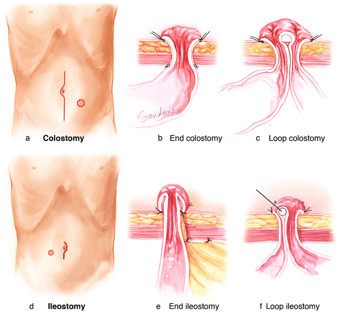The practical nurse (PN) is assisting with preparation of a client for fecal diversion surgery. While inserting an indwelling urinary catheter, the client asks if the surgical opening will be visible.
Which action should the PN implement?
Review the client's expectations of elimination after surgery.
Verify that the client had nothing by mouth (NPO) for the past 24 hours.
Ask the client if he finished the bowel sterilization prescription.
Determine if this is the first indwelling catheter the client has had.
The Correct Answer is A
This is the best action for the PN to implement because it addresses the client's question and provides an opportunity to educate the client about the fecal diversion surgery and its outcomes. The PN should review the type, location, and appearance of the surgical opening (stoma) and explain how it will affect the client's elimination and body image.

Nursing Test Bank
Naxlex Comprehensive Predictor Exams
Related Questions
Correct Answer is A
Explanation
Choice A rationale:
After administering hydrocodone/acetaminophen for pain, the PN should closely monitor the client for signs of respiratory depression, which may manifest as shallow or slow breathing.
Ongoing assessments are crucial because respiratory depression is a potential adverse effect of opioid medications like hydrocodone. If this complication is detected early, appropriate interventions can be implemented to ensure the client's safety.
Choice B rationale:
Assessing the skin daily for areas of ecchymosis or other signs of bleeding is not directly related to the administration of hydrocodone/acetaminophen. While bruising and bleeding are possible side effects of some medications, this assessment is not the priority in this scenario.
Choice C rationale:
Encouraging the client to resume normal activities after medication administration is not appropriate in this situation. Hydrocodone/acetaminophen can cause drowsiness and impairment, so the client should be advised to avoid activities that require alertness or coordination until the effects of the medication are known.
Choice D rationale:
Observing the client for involuntary movements of the lips and tongue is relevant when administering antipsychotic medications, as these movements may be signs of tardive dyskinesia. However, it is not directly related to the use of hydrocodone/acetaminophen. The priority after administering this pain medication is to monitor for respiratory depression, as opioids can affect the respiratory system
Correct Answer is B
Explanation
Ask the client to describe what happened.
Calling the agency-based client advocate (Choice A) should not be the first action taken in this situation. While involving an advocate might be necessary at some point, it is more appropriate to address the client's concerns and gather information about the incident first.
Completing a client adverse incident report (Choice C) is an important step to document theevent and any potential issues, but it should not be the first action taken. Before completing the report, the nurse needs to understand the situation from the client's perspective.
Informing the charge nurse of the situation (Choice D) is a reasonable step, but it should not be the first action. It may be necessary to escalate the issue, but understanding the situation from the client's viewpoint should be prioritized.
Whether you are a student looking to ace your exams or a practicing nurse seeking to enhance your expertise , our nursing education contents will empower you with the confidence and competence to make a difference in the lives of patients and become a respected leader in the healthcare field.
Visit Naxlex, invest in your future and unlock endless possibilities with our unparalleled nursing education contents today
Report Wrong Answer on the Current Question
Do you disagree with the answer? If yes, what is your expected answer? Explain.
Kindly be descriptive with the issue you are facing.
